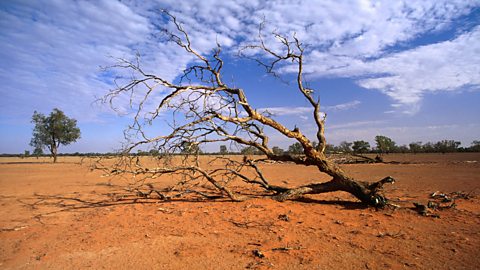Case study - the impact of drought in a developed country - Australia
Between 2015 and 2016, the south-east of Australia experienced drought. This was attributed to a very strong El Ni├▒o, climate pattern, where moist trade winds are reversed; instead of bringing rainfall to Australia they travelled west towards South America, leaving south-east Australia with a lack of rainfall. Some scientists believe climate change exacerbated this drought by increasing temperatures and reducing rainfall. Australia experienced its fourth-warmest year on record during 2016, with national temperatures 0.87Ôäâ above average.

The drought was widespread. Parts of Western Australia, the Northern Territory, Queensland, and New South Wales experienced record low levels of rainfall. These areas provide much of Australia's water and agricultural produce. They are also home to aover 60% of the countryÔÇÖs total population.
Impact of the drought
The drought had severe impacts on both people and the environment.
People
- Low rainfall during the growing season led to crop failure
- With fewer crops and livestock, Australia had to import more food. This increased the price of food for the whole country
- Those living rurally found it more difficult to access clean drinking water and staple foods
- Water restrictions were enforced
- The wine industry was affected by the lack of water and the risk of fire.
Environment
- Less energy was generated through hydroelectric power. Hydroelectric power is a clean energy source.
- Wildfires caused by drought destroyed vegetation and animals' habitats.
- The drought was replaced by heavy rains in May, which led to flooding.
- The largest recorded mangrove dieback took place . Mangroves provide habitats and protect coastlines from extreme weather and erosion.
How people adapted to the drought
- The Australian state and territory governments signed the National Drought Agreement (NDA). This aims to find ways to help farmers to prepare for, manage and recover from drought.
- The country is investing in large desalination plants, which turn seawater into safe drinking water. This is costly but will help to protect against drought.
- Perth, a city on the west coast, is pumping 10% of its treated wastewater underground. The rocks beneath the ground naturally filter and store the water so that it can be used again.
- Many Australians are trying to use less water. Some products, such as dishwashers, are rated for water efficiency. More and more homes are using water-saving devices, such as aerated taps and showerheads.
- Recycled water use is increasing. More than a quarter of Australian homes collect and store rainwater, which they use to water gardens and wash cars.